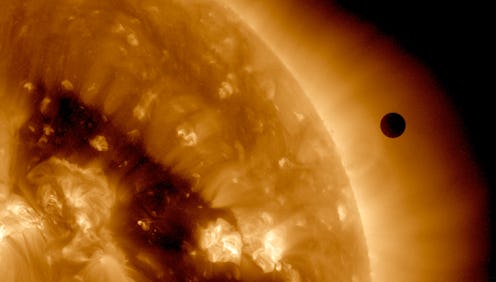Life
More Than Just The Sun Will Be Visible During The Solar Eclipse

It's finally here — the "Great American Eclipse" is already starting to cast epic shadows across the United States. And while the darkened or bitten sun is surely the main event, you'll also want to be sure to see how Mercury, Venus, Mars, and Jupiter will be visible during the solar eclipse.
That's right, all the celestial giants are coming out to play, making it maybe the most exciting Monday in recent history.
Between 15 to 30 minutes before totality, Venus will slowly come into view, to the west of the Sun. It will be the brightest planet in view during the eclipse, and most should be able to see it without a telescope, even in parts of the country that will only have a partial eclipse.
Next up is Mars, which will appear about 30 seconds before and after totality. Though you'll need a telescope to see it if you're in a partial eclipse region, you'll recognize the planet because it will look orange and be eight degrees west of the sun.
Also visible through a telescope if you're in a partial eclipse area will be Mercury, located 10 degrees east of the sun. These two planets will be very faint due to their close proximity to the sun, so you'll have to really look for them — making their presence an even more special treat. Typically, the sun's atmosphere obscures the planets closest to it, making it difficult for them to stand out.
The last planet to show itself will be Jupiter, but you'll only see it if you live west of Idaho.
So, if you won't have access to a telescope, or you won't be within the path of totality, Venus will be the planet you're most likely to see. Here's what she looks like in all her glory:
If you're looking through a telescope, you'll notice that the order of brightness for these planets will be: Venus, Jupiter, Mars and Mercury — though, of course, Mars will stand out due to its color.
In addition to planets, many bright stars will be visible near the eclipsed sun. If you think about it, it makes perfect sense that you'd able to see constellations, as the sky will become incredibly dark. You might want to download a constellation app to help you locate the stars if you're not familiar with their locations. You'll want to find Sirius, which will be southwest of the sun, and Arcturus and Capella which will be found to the east and northeast of the sun. And, if you look extra hard, you will be able to see Regulus right next to the eclipsed sun, as it's brightest star of Leo’s constellation.
No matter what you're looking for in the sky, make sure that you're wearing NASA-approved glasses with an ISO of 12312-2, and that if you're using a telescope that has a proper solar filter. No sight is worth risking permanent eye damage!